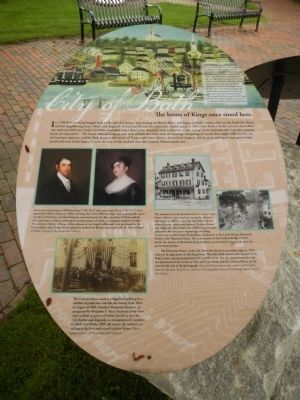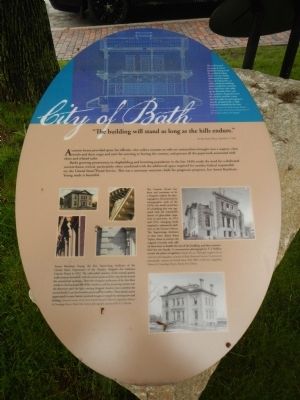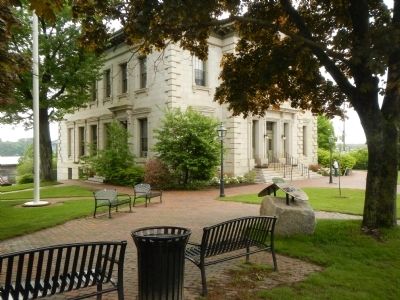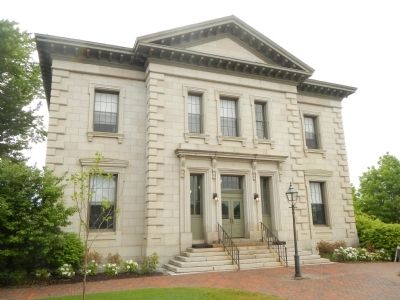Bath in Sagadahoc County, Maine — The American Northeast (New England)
City of Bath

Photographed By Barry Swackhamer, June 6, 2014
1. The home of Kings once stood here Marker
Captions: (top) This detail from the 1844 painting, “View of Bath” by H.A. Hillings, show the William and Ann King home, tucked into a crowded waterfront on the Kennebec River. Chosen when Shaw’s Point was still largely undeveloped in the late eighteenth century, the site was perfect in the following decades to keep an eye on both river activity and the bustling downtown. The King home is directly above the American flag at the back of steamboat.; (portraits on left) These two oil portraits of William King (1768-1852) and Ann Frazier King (1782-1857) were painted by Gilbert Stuart ca. 1806, not long after their 1802 marriage. Their married life, spent entirely in this home, included frequent entertaining for the first governor Maine and his wife. and many a history mentioned common games of whist, a card-game related to bridge. The extensive library of King, whose education was largely self-taught, was purchased by the Patten family after King’s death and given to the local library, associated with the Patten family of Bath.; (photographs on right) The mansion was moved south and west across Vine Street, where it was reused as a tavern for decades, averted in 1867 as a one-minute walk for the railroad depot, steamboat landing, Custom House, and telegraph office. Often the establishment’s name referred to the structure’s beginnings, the King’s Tavern, but at other times the building was known as the Leach House, Elmwood House or the Shannon House. The construction of the Carlton Bridge in 1927 meant the demise of the former King mansion, as once more it was in the way of a government project. The Elmwood House, to the left, shows the tavern in an earlier stage ca. 1891, closer to its appearance as the King home. The early 20th-century photograph of the King Tavern captured preparation for a public event, but also documented the relative placement of the tavern at Vine and Front Street and the Custom House on the extreme left side of the photograph.; (photo on bottom, left) The Custom House acted as a dignified backdrop for a number of politicians visiting Bath. Here in August of 1889 Benjamin Harrison, accompanied by Benjamin F. Trace, Secretary of the Navy, came to Bath as guests of Arthur Sewall, to view the city’s harbor and shipyards, in anticipation of a contract, resulting in the first steel vessels built in Maine.
The home of Kings once stood here.
In 1798 William King bought land in the new downtown, just starting on Shaw’s Point, and began to build a home close to the Kennebec River and his neighboring store, wharf, and shipyard. A year later he met the woman he would marry in 1802, Ann Frazier. In the years to come their one-and-one-half story home would be expanded into a three-story mansion; until it became, as one young visitor remembered, “a perfect treasure house of enjoyment.” The house allowed King an easy view of both the river, with the comings and goings of vessels that might influence his varied business interests, and his Bath Bank at the corner of Front and Centre Streets. An orchard of plum, cherry, pear, and apple trees grew to the north and west of the house. It is on the site of that orchard that this Custom House stands now.
“The building will stand as long as the hills endure.”The Bath Daily Tribune, September 15, 1856
A custom house provided space for officials, who collected customs or tolls on commodities brought into a seaport, clear vessels and their cargo and crew for entering or leaving the country, and process all the paperwork associated with these and related tasks.
Bath’s growing prominence in shipbuilding and booming population in the late 1840s made the need for a dedicated custom house critical, particularly when combined with the additional space required for another federal responsibility, the United States Postal Service. This was a necessary structure, built for pragmatic purposes, but Ammi Burnham Young made it beautiful.
Erected by City of Bath.
Topics. This historical marker is listed in this topic list: Industry & Commerce. A significant historical date for this entry is September 15, 1856.
Location. 43° 54.742′ N, 69° 48.816′ W. Marker is in Bath, Maine, in Sagadahoc County. Marker is on Lambard Street near Front Street, on the right when traveling east. Touch for map. Marker is at or near this postal address: 50 Lambard Street, Bath ME 04530, United States of America. Touch for directions.
Other nearby markers. At least 8 other markers are within 2 miles of this marker, measured as the crow flies. A different marker also named City of Bath (within shouting distance of this marker); Bath Street Clock (within shouting distance of this marker); Constable William Lawrence (about 400 feet away, measured in a direct line); All Gave Some, Some Gave All - Vietnam War (about 500 feet away); Bath Civil War Memorial (approx. 0.3 miles away); Deckhouse from steamer Winapie ca.1909

Photographed By Barry Swackhamer, June 6, 2014
2. “The building will stand as long as the hills endure.” Marker
Captions: (top) The architectural drawings of Ammi Burnham Young reveal the careful detailing inside and out. Young understood the importance of making this a visually prominent building, which would draw attention from both those who sailed up the Kennebec River and area residents. Young also knew the absolute need for a structure that safely housed important records, designing this to high fireproof standards for the time.; (bottom, right) The Custom House has been and continues to be a frequent subject of photographers. Documented in stereographic cards of the 1870s, the small, jewel-box of a building also was captured with the remarkable clarity of glass-plate negatives as seen here. In 1911 and 1912, changing needs required a substantial addition to the Custom House. The Supervising Architect at the time , James Knox Taylor, chose to remove the original riverside wall, added three bays to double the size of the building, and then reassembled the rear facade. A construction photograph by F.J. Rollins reveals the plan’s complexity.; (bottom, left) Ammi Burnham Young, the first Supervising Architect of the United States Department of the Treasury designed this Italianate Custom House in 1852. The well-crafted masonry of the smooth granite walls contrasts beautifully with the corner quoins and the crisp details around the ornamental openings. There the triangular pediments of the first-floor windows, the bracketed sills of the windows, and the projecting cornice over the doorways catch the light, creating dramatic shadows the underline the carved details. Cast-iron brackets punctuate the roofline. These details can be appreciated in many historic postcard images, or simply by turning now and looking.
Also see . . .
1. William King (governor). William King was an American merchant, shipbuilder, army officer, and statesman from Bath, Maine. A proponent of statehood for Maine, he became its first Governor when it separated from Massachusetts in 1820. (Submitted on September 13, 2014, by Barry Swackhamer of Brentwood, California.)
2. The Custom House - Bath's Historic Downtown. According to the 1851 map of Bath, three separate buildings occupied the property where the Customs House was later built. On the map, the buildings on the property were an engine house and two other houses that were owned by J. Lambard and C .W King, the son of William King, the first governor of Maine. (Submitted on September 13, 2014, by Barry Swackhamer of Brentwood, California.)
Credits. This page was last revised on June 16, 2016. It was originally submitted on September 13, 2014, by Barry Swackhamer of Brentwood, California. This page has been viewed 652 times since then and 45 times this year. Photos: 1, 2, 3, 4. submitted on September 13, 2014, by Barry Swackhamer of Brentwood, California. • Bill Pfingsten was the editor who published this page.

